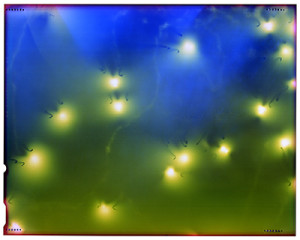Andrew Russel Coates

Statement:
Back in school, while exploring the design potential of emotion as a means to confront, rather than inspire, impulsive consumerism, I created a molded rubber mason-jar nightlight with LEDs inside programmed to simulate the flashing of fireflies. My hope was to create utility objects with iconic meaning that would establish a personal attachment. I ultimately rejected the thesis for various reasons, including what I saw as the deception and superficiality of nostalgia. But my fascination with fireflies and the fond summer memories of catching them remained. Nostalgia, like romance, is not so willfully suppressed.
So one summer evening at dusk as the fireflies emerged, sparkling the fields and trees around my childhood home, an idea formed: I wondered how, if at all, their natural luminescence would expose a sheet of film if placed together in an enclosed space. Like in a mason jar.
A daily task ensued: At dusk, in a somewhat light-proof, spray-painted jar covered by a suede leather lid with an “X” cut in it, I placed a sheet of 4” x 5” color negative film, followed by several live fireflies. It was an exercise of pure curiosity with few expectations. I figured if the bugs’ light produced anything at all it would probably just be a dim wash of diffuse color, but still I had hope for something more definite and aesthetically interesting.
Indeed, the first images processed were as I feared. But because I screwed up. By removing the (color) film from the jar under a red light, the first few images were just solid red/pink washes. Pretty, but disappointing. However, some showed clear evidence of the fireflies’ presence—paths (while in flight?!) and silhouettes of the bugs themselves! And the red hues were great.
I refined the process to be more lightproof (and more neutral/ less incompetent—no more red light), but serendipity still prevailed. Each image was a surprise, outside light still leaked, and a lab also erred, mistakenly cross-processing a summer’s worth of 8” x 10” color transparency film, dramatically shifting the colors… pleasantly.
The final results—though some are entirely unadulterated by anything but the bugs’ own luminescence—are not a scientific conclusion. They are an aesthetic one that appeals to my interests in the complexities of minimalism and color, and the inherent beauty and recognizability of nature, even in such a synthetic setting. They also possessed enough consistency for me to indulge, with restraint, my own aesthetic editing to achieve an abstract work that allows subjective interpretation beyond their typically nostalgic origin. It’s the effect I sought, but could not achieve by designing a product.
Bio:
Andrew Russel Coates drew sports cars, superheroes and schematics of complex underground habitats below Snoopy’s doghouse during a bucolic childhood on a small farm in rural northeast Pennsylvania until he was directed away from art by the practical powers that be and entered the Pennsylvania State University as an architectural engineering major, got bored, joined a fraternity, and switched to pre-med (BS 1996). After working in various medical jobs, he rejected that field too, but was again struck by the ensuing onus of career when faced with acceptance to the nation’s best dental school. What an awful idea. Emboldened by a magazine ad, Coates pursued furniture design, a decidedly better application of his interests and heritage (lapsed PA Dutch), and eventually arrived at the Rhode Island School of Design (MFA 2003), where he didn’t make much furniture. Since then, based in Brooklyn, Coate’s disparate, often derivative work primarily explores the paradoxical nature of meaning.
Artist’s Website: a-coates.com
